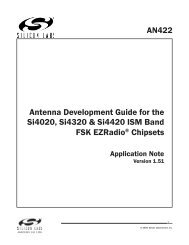C8051F326/7 - Silicon Labs
C8051F326/7 - Silicon Labs
C8051F326/7 - Silicon Labs
You also want an ePaper? Increase the reach of your titles
YUMPU automatically turns print PDFs into web optimized ePapers that Google loves.
<strong>C8051F326</strong>/7<br />
10.2. Internal Low-Frequency (L-F) Oscillator<br />
<strong>C8051F326</strong>/7 devices include a low-frequency oscillator. The OSCLCN register (see SFR Definition 10.3)<br />
is used to enabled the oscillator.<br />
SFR Definition 10.3. OSCLCN: Internal L-F Oscillator Control<br />
R/W R R R R R R R Reset Value<br />
OSCLEN — — — — — — — 0xxxxxxx<br />
Bit7 Bit6 Bit5 Bit4 Bit3 Bit2 Bit1 Bit0 SFR Address:<br />
0xE3<br />
Bit7: OSCLEN: Internal L-F Oscillator Enable.<br />
0: Internal L-F Oscillator Disabled.<br />
1: Internal L-F Oscillator Enabled.<br />
Bit6–0: Unused. Read = 0000000b. Write = don’t care.<br />
10.3. CMOS External Clock Input<br />
A CMOS clock can be used as an external clock input. The CMOS clock should be wired to the XTAL2 pin<br />
(P0.3) as shown in Figure 10.1 on Page 71. Port pins must be configured when using the external oscillator<br />
circuit. The Port I/O Crossbar should be configured to allow digital inputs be setting INPUTEN (GPI-<br />
OCN.6). Also, P0.3 should be configured to open drain mode. See Section “11. Port Input/Output” on<br />
page 79 for more information.<br />
74 Rev. 1.1


